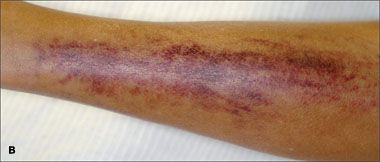- Clinical Technology
- Adult Immunization
- Hepatology
- Pediatric Immunization
- Screening
- Psychiatry
- Allergy
- Women's Health
- Cardiology
- Pediatrics
- Dermatology
- Endocrinology
- Pain Management
- Gastroenterology
- Infectious Disease
- Obesity Medicine
- Rheumatology
- Nephrology
- Neurology
- Pulmonology
Scurvy, Pellagra, and Beri Beri
A 38-year-old woman presented with bruising and pain of the lower extremities and dyspnea on exertion. She had had these symptoms for 3 weeks. She denied hematuria, melena, hematemesis, fever, or abdominal pain. Results of routine blood work showed a hemoglobin level of 6.4 g/dL (19 months earlier, this level was 15.8 g/dL).
A 38-year-old woman presented with bruising and pain of the lower extremities and dyspnea on exertion. She had had these symptoms for 3 weeks. She denied hematuria, melena, hematemesis, fever, or abdominal pain. Results of routine blood work showed a hemoglobin level of 6.4 g/dL (19 months earlier, this level was 15.8 g/dL).
The patient's history included chronic idiopathic urticaria and a self-reported anaphylactic reaction to an unknown food. The patient initially denied an eating disorder but later admitted to an exclusive diet of hamburger meat, pretzels, and diet sodas.

Gingival swelling (A) and large, bilateral, confluent ecchymoses on her lower extremities (B) were noted. Remaining physical findings, including neurological findings, were normal.
Results of a Coombs test; levels of haptoglobin, methylmalonic acid, red blood cell folic acid, vitamin B12, and lactate dehydrogenase; a complete metabolic profile; prothrombin time; activated partial thromboplastin time; and ristocetin cofactor and factor VIII activity were all normal. An iron profile was consistent with anemia of chronic disease. The patient's symptoms and limited diet led to the consideration of scurvy. Her vitamin C level was less than 0.12 mg/dL (range, 0.2 to 1.9 mg/dL), which confirmed the diagnosis.

Easy access to fresh fruits and vegetables, supplemental vitamins, and vitamin-fortified foods has led to the prevailing belief that scurvy is more of a historical disease than a current health risk. Nonetheless, the incidence of vitamin C deficiency is strikingly high; the Third National Health and Nutrition Examination Survey reported that 14% of men and 10% of women were vitamin C deficient.1 Thus, scurvy may be underdiagnosed, especially in patients with eating disorders or restricted diets.
Humans are at risk for vitamin C deficiency because they are unable to synthesize ascorbic acid and are completely dependent on exogenous sources for the daily requirement. The recommended daily allowance of vitamin C intake is 90 mg/d for men and 75 mg/d for women; the amount required to prevent scurvy is 46 mg/d.2
Vitamin C is essential for collagen synthesis by acting as a reversible reducing agent for lysine and proline hydroxylation. Many of the clinical manifestations of scurvy are attributable to defective collagen synthesis, including spontaneous soft tissue bleeding, gingival swelling, hyperkeratosis, "corkscrew hairs," anemia, and myalgias. In a study of 5 persons with strictly restricted diets, symptoms of scurvy developed between 29 and 90 days.3 Atypical symptoms include hemarthrosis, hemorrhagic pleural effusions, hemopericardium, and sudden death, which have been reported within 6 months after the onset of scurvy.4,5
This patient was treated with vitamin C (500 mg twice daily). Five weeks after discharge, her symptoms had resolved, her hemoglobin level had risen to 14.2 g/dL, and her vitamin C level had normalized.
References:
REFERENCES:
1.
Hampl JS, Taylor CA, Johnston CS. Vitamin C deficiency and depletion in the United States: the Third National Health and Nutrition Examination Survey, 1988 to 1994.
Am J Public Health.
2004;94:870-875.
2.
Institute of Medicine.
Dietary References Intake for Vitamin C, Vitamin E, Selenium, and Carotenoids.
Washington, DC: National Academy Press; 2000:chap 5.
3.
Hodges RE, Baker EM, Hood J, et al. Experimental scurvy in man.
Am J Clin Nutr.
1969;22:535-548.
4.
Pimentel L. Scurvy: historical review and current diagnostic approach.
Am J Emerg Med.
2003;21:328-332.
5.
Suvarna J, Tamhankar PM, Deshmukh CT. Hemorrhagic pleural effusion: can it be scurvy?
Indian J Pediatr.
2007;74:1050-1051.
